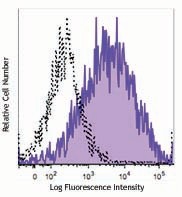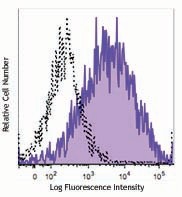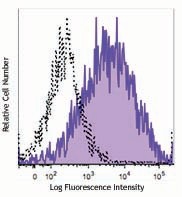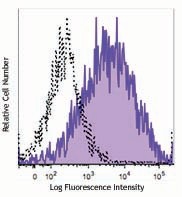商家描述
产品评价(0)
Clone
10D1-J16 (See other available formats)
Regulatory Status
RUO
Other Names
Chemokine (C-X-C motif) receptor 7, RDC1, CMKOR1, GPR159, ACKR3
Isotype
Mouse IgG2a, κ
Antigen Details
Structure
G Protein-Coupled Receptor super family
Distribution
Monocytes, B cells, T cells, and mature dendritic cells.
Function
Regulates trafficking and activation of leukocytes.
Ligand/Receptor
CXCL12/SDF-1 and CXCL11/I-TAC.
Cell Type
Monocytes, B cells, T cells, Dendritic cells
Biology Area
Cell Biology, Immunology, Signal Transduction
Molecular Family
CD Molecules, Cytokine/Chemokine Receptors, GPCR
Antigen References
1. Torossian F, et al. 2014. Blood 123:191.2. Walentowicz-Sadlecka M, et al. 2014. PLoS One 1:e84629.3. Yates TJ, et al. 2013. Cancer 119:61.4. Burns JM, et al. 2006. J. Exp. Med. 203:2201.5. Infantino S, et al. 2006. J. Immunol. 176:2197.
Gene ID
57007
CXCR7, also known as RDC1, belongs to a subgroup of C-X-C chemokine receptors, which are part of a large protein family of G protein-coupled receptors (GPCR). CXCR7 binds with a high-affinity to CXCL12/SDF-1 and CXCL11/I-TAC, which regulates the trafficking and activation of leukocytes. It is also a co-receptor for the entry of HIV-1. The binding of a ligand to CXCR7 induces proliferation and migration of immature neurons, glia, and their precursors. CXCR7 expression occurs on a wide variety of tissues and cells including monocytes, B cells, T cells, and mature dendritic cells. Surface expression of CXCR7 has been also reported in tumor cells, activated endothelial cells, and fetal liver cells.














 会员登录
会员登录.getTime()%>)
 购物车()
购物车()






 成功收藏产品
成功收藏产品